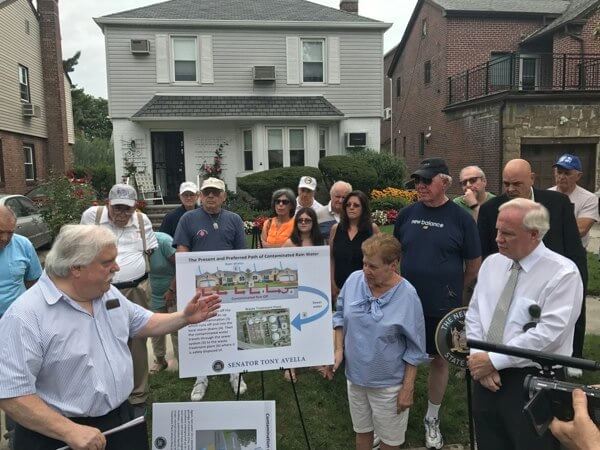By Mark Hallum
State Sen. Tony Avella (D-Bayside) broke the news to civic leaders Monday that a full opt-out program for the city Department of Environmental Protection’s initiative to install bioswales throughout Flushing will not be in the cards.
Instead, the DEP informed the Queens politician that the agency would only be making exceptions for seniors with handicap placards on their vehicles and homeowners with sprinkler systems installed in their lawns.
“From one end of the borough to the other end of the borough, Queens has spoken,” Avella said. “Queens homeowners have come out in force to tell the Mayor that they want the option to opt-out of the bioswales program. However, once again, the concerns of homeowners are being ignored by this mayor. City administration continues to make demands from the top without ever consulting the community to see if this is something that would work. There are a lot of people in Queens that would be greatly harmed by the presence of a bioswale in front of their home and many who do not wish to add maintenance of a bioswale to their daily routine. So here we are again, disappointed by the city’s decision; but hopeful they will heed our call and change their mind.”
Bioswales are green infrastructure installations that cut into the pavement to absorb rainwater and remove some of the burden from the sewer system. The ultimate goal of a bioswale project is to clean up waterways — in this case, Flushing Creek and Flushing Bay, a DEP spokesman said in July.
A similar project in Brooklyn, launched in June by the city agency, will cost $35 million and install more than 800 bioswales to improve water quality in Jamaica Bay. But Peter Kaufman, a research scientist and Chief Technology Officer from Digital Direct IR, argued that allowing water to flow into these installation could contaminate the water table, which sits high in much of northeast Queens.
Joseph Branzetti, president of the Friends of Fort Totten Parks, said that in his neighborhood of Murray Hill, DEP communication about the initiative with residents was minimal and he only found out by asking workers prospecting outside his home. They were marking sidewalks with green paint to keep track of locations where soil conditions would be suitable for a bioswale.
DEP celebrated the successful installation of 115 bioswales in northeast Queens on Tuesday in a press release that explained the benefit of the what the agency also calls “rain gardens” to the overall health to the city’s coastal waterways.
“Rain gardens capture stormwater runoff before it can drain into the combined sewer system, which protects the health of Flushing Creek and Flushing Bay by reducing the likelihood of any overflows,” DEP Acting Commissioner Vincent Sapienza said. “Crews will regularly maintain each garden to ensure the plantings are healthy and continue to beautify the neighborhood and clean the air.”
The installation of 321 bioswales in Maspeth, Ridgewood and Sunnyside began in June, 2016, with the aim of cleaning up Newtown Creek — which separates Queens and Brooklyn and catches up to 38 million gallons of rainwater every year, according to DEP..
The creek is one of the nation’s most polluted waterways with heavy industrial development along the banks of its 3.5-mile length. Over 50 oil refineries dumped an estimated 30 million gallons of fuel in the creek, along with toxins from petrochemical plants, fertilizer, glue factories and other industries starting in the early 1800s.
Reach reporter Mark Hallum by e-mail at mhall
































